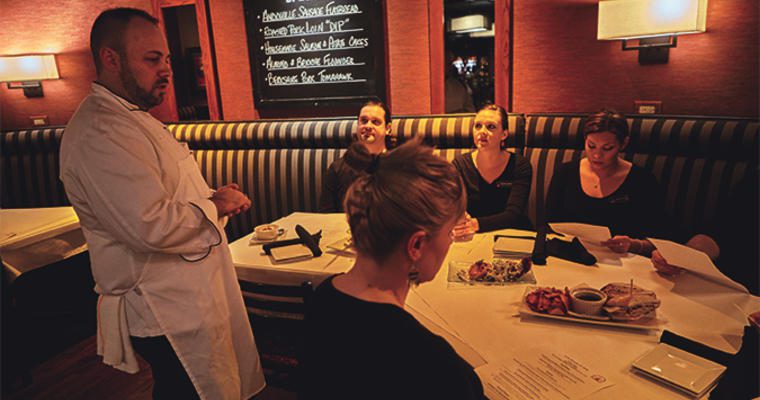Change is difficult. Most people dislike uncertainty and ambiguity, and change creates heaping helpings of both. But change is inescapable, especially in the foodservice industry, where everything from food costs to consumer preferences is constantly in flux.
Dealing with these shifting developments can overwhelm an operator. Yet doing so is vital to success. We asked several Gordon Food Service experts to share their strategies for managing change.
Look ahead
Change isn’t as intimidating if it’s not a surprise. “Look ahead six months, 12 months, 36 months,” advises Indianapolis-based Commercial Segment Leader Bob Koch. “Read the news and pay attention to trends. Is what you’re doing now going to work for the future?” Probably not, so create a plan to evolve and prioritize what needs to be done.
Give it time
Planning for change takes time—a scarce commodity for operators. Todd Gross, Commercial Segment Leader for the Columbus, Ohio area, says it’s helpful to assign a set number of weekly hours to your change efforts.
“Focus on two or three things you need to address and figure out how much time you can spend on them,” Gross says. “Is it five to 10 hours a week? Fifteen to 20 hours? Thirty to 40 hours? That will determine how quickly you can accomplish your goals.”
Build a team
You don’t have to be alone in racking up those hours. Grand Rapids, Michigan-based Commercial Segment Specialist Geoff Bonham says cross-departmental teams are an effective way to manage and execute change. “I know of one multiunit, regional casual-dining chain that assembled a task force of individuals from different departments around the company to help create a new fast-casual concept,” he says. “Their ideas are driving the firm’s growth into the future.”
The team approach also works on a smaller scale. “Another operator put together a team specifically to shrink their menu from 90-plus items to 72 items,” Bonham continues. “The team was involved in every decision, including which items would be deleted or consolidated, and how the changes would be communicated to staff and guests.”
Bringing together people with diverse experiences, perspectives, and skills stimulates innovation and creativity, which is exactly what you want when dealing with change.
Plan for success
Delaware-based Divisional Trainer Matt Miller believes managing change should be strategic, not spur of the moment. “Create a timeline for the planning, rollout, and follow-up for any change you are going to implement,” he suggests. “Assign specific areas of responsibility to other leaders in your organization and routinely schedule brief follow-up meetings with all involved to pinpoint any challenges, pitfalls, and new developments.”
Setting a “go-live” date is essential. “You don’t want be overly aggressive with your timeline on implementing the change,” Miller cautions. “Choose a date you and your leaders are confident you can meet, and be firm with it. Then publish the go-live date for the entire staff to see.”
Miller also urges operators to involve peer leaders in change efforts. Peer leaders may not have managerial titles, but they exert a great deal of influence over their co-workers. “If you get the buy-in of peer leaders, you’ll significantly increase the organization’s overall level of acceptance of the change.”
Talk it out
“You really need your staff on your side if you’re going to make a significant change in branding, menus, and procedures, especially,” Bonham adds. “I recommend that operators very clearly communicate to staff the reason for the changes, and allow team members to ask questions and challenge you. Then provide a little time for the new reality to set in. Being transparent can help convert your team into your biggest advocates for change.”
This not only improves the odds of any changes being implemented successfully; it also helps ensure that changes will be communicated to guests positively and energetically.
Make it routine
“Foodservice is constantly changing, and operators need to be constantly changing, too,” stresses Cleveland-based Commercial Segment Specialist Vicki Thompson. “Menus are the easiest place to address shifting consumer demands and food-cost fluctuations.”
Thompson urges operators to commit to menu flexibility. “I’m thinking of two customers who are constantly testing new concepts via limited-time offers, and adding them to the menu if they’re successful. It’s just part of their DNA to be constantly looking for new ideas, and it’s on their calendars and mine to meet regularly and discuss new ways to keep things fresh and interesting for their customers.”
The Gordon Food Service Annual Trends Report, written by Corporate Consulting Chef Gerry Ludwig, CEC, is Thompson’s “favorite tool” for prompting menu discussions.
“By highlighting the latest culinary and menu innovations coming out of the nation’s hottest restaurants, the Annual Trends Report helps guide operators in making menu changes,” he says. “And it often pushes them out of their comfort zones, to profitable effect.”
Set a budget
Change usually carries a price tag. “National chains budget in advance for everything from menu makeovers to restaurant remodels,” says Rob McMillion, Segment Marketing Specialist for the Great Lakes West region. Many independent operators don’t do that, he contends, which tends to discourage them from making timely proactive changes.
“Set aside money on a regular basis to fund changes that will inevitably be needed, especially physical ones,” McMillion advises. He also urges operators to be mindful of their investments. “You have to dig into what changes mean for you from a financial standpoint. Evaluate them in terms of your business fundamentals and whether they will support your brand and your bottom line.”
Make change work for you
“Change is inevitable,” says Chad Keeling, a Georgia-based Marketing Services Manager. “You either drive the conversation or your competition drives it for you. Embrace change and allow it to be a leading source for growth.”




























